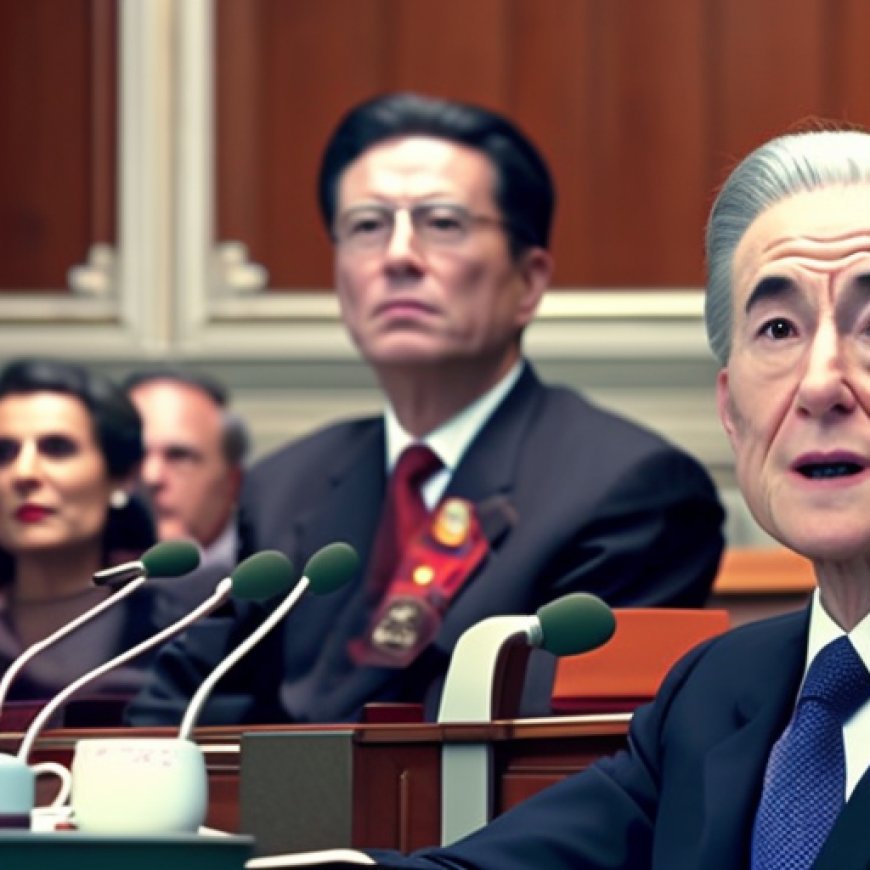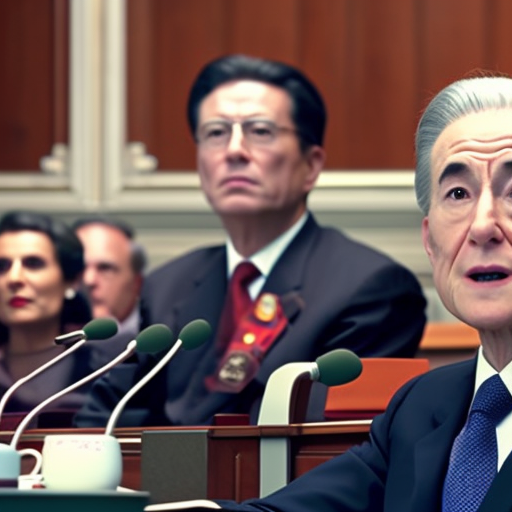China’s economic woes loom over Raimondo’s high-stakes visit
China's economic woes loom over Raimondo's high-stakes visit POLITICO


QUICK FIX
U.S. Secretary of Commerce Gina Raimondo to Visit China
U.S. Secretary of Commerce Gina Raimondo is expected to visit China this week, as the country’s financial crisis complicates the Biden administration’s efforts to enhance communication while hobbling Beijing’s high tech sectors.
Mexico Expands Tariffs on Steel Imports from China
The Office of the U.S. Trade Representative praised Mexico’s decision to expand tariffs to 25 percent on steel imports from China and other economies that don’t share a free trade agreement with the country.
Taipei and Washington Discuss Cooperation
Taipei and Washington discussed cooperation over food security, conservation efforts, and labor standards as part of the second negotiating round under a bilateral trade initiative.
Driving the Day
China’s Economic Lifeline
Gina Raimondo is expected to arrive in China this week amid the country’s worsening financial crisis and as the White House seeks to revive high-level communication between the world’s largest economies.
The Commerce secretary is at the forefront of the Biden administration’s efforts to curb China’s access to advanced technology, and her arrival comes as Beijing faces plunging exports and foreign investments, and soaring youth unemployment.
The commerce department has kept tight-lipped about the highly-anticipated trip, and has not officially confirmed the schedule. The Chinese embassy said Thursday it would welcome Raimondo, but warned that Beijing is considering retaliating against a White House order to restrict American investment into advanced technology sectors in China.
Beijing’s financial woes could tee up leverage for Washington upon her arrival. But Raimondo can also expect added pressure in talks with Chinese officials to ease long-standing trade restrictions, which the Biden administration categorizes as part of a “de-risking” strategy to restrict China’s access to technology that could fuel the country’s military.
Raimondo’s task list for her meetings with her Chinese counterparts will likely include the perennial issue of market access restrictions against American companies and the recent spate of Chinese police raids on the Beijing-based operations of U.S. firms including Mintz and Bain & Company, per Doug Palmer and Phelim Kine.
Officials could also discuss opening up more sectors for foreign investors between China and Washington, even as the U.S. moves to restrict trade in a narrow set of advanced technology sectors.
Not all about Beijing: The IMF warned in a July report that China’s underperforming reopening from the pandemic was dragging down the global economic recovery. “China’s slowdown will have the largest impact on its Asian neighbors, but there will be some spillovers to the United States,” added Treasury Secretary Janet Yellen, per Bloomberg.
Raimondo’s visit plays a dual role. The Commerce secretary’s Bureau of Industry and Security is responsible for administering export controls aimed at hobbling China’s access to advanced technology that could fuel the country’s military. But Raimondo is also hoping to expand the export of American goods to China, which remains Washington’s third largest export market.
That pits Raimondo against Republican hawks on the Hill, who will be closely watching the visit. A coalition of Republicans including Mike Gallagher, who chairs the House Select Committee on China, sent a letter that said “decisions on the nature and scope of U.S. export controls should be taken in Washington, not Beijing.”
Other lawmakers wonder if the trip is worth the effort given scant returns from other senior officials recently in the country, including Yellen, Secretary of State Antony Blinken, and U.S. climate envoy John Kerry.
Mexican Tariffs Signal Alignment on China
USTR praised the decision by the Mexican government to expand tariffs on imports of steel from nations that don’t share a free trade agreement with the country and said Washington “welcomes Mexico’s efforts to address global non-market excess capacity in the steel sector.”
Sam Michel, a USTR spokesperson, said in a statement on Friday that the U.S. “looks forward to continuing discussions with Mexico to address the recent surge of imports of steel and aluminum products into the United States and to ensure greater transparency with regards to Mexico’s steel and aluminum imports from third countries.”
Mexico’s decision is a thorn in the side of China, as well as South Korea and India, which are some of Mexico’s most important trading partners but are not among the more than 50 countries with which Mexico maintains some version of a free trade agreement.
Jorge Guajardo, a partner at Dentons Global Advisors and Mexico’s former ambassador to China, told Morning Trade that “it’s an easy position to take against China. It scores political points in the United States, while being neutral-to-positively received in Mexico.”
The rundown: Mexico will raise temporary tariffs on nations that don’t share a free trade agreement with the country from 15 percent to 25 percent on items related to the steel industry. Mexico is also expanding tariffs on a wider range of products, including rubber, glass, electronics, textiles, and auto parts, and said the restrictions are critical “in order to avoid the affectation of production chains and to maintain competitiveness” in key sectors. The decree ends its validity on July 31, 2025, the document notes.
Taiwan Talks in Focus
The U.S. and Taiwan launched their second round of negotiations under the U.S.-Taiwan Initiative on 21st Century Trade signed this year and held days of in-person discussions on agriculture, labor, and the environment.
The two sides held talks between Monday and Friday of last week, USTR said in a statement on Friday, which added that “conversations were productive and officials will continue to hold discussions in the months ahead in order to reach consensus.”
The trade negotiations were kept under wraps until after their conclusion, partly over concerns about
SDGs, Targets, and Indicators in the Article
1. Which SDGs are addressed or connected to the issues highlighted in the article?
- SDG 8: Decent Work and Economic Growth
- SDG 9: Industry, Innovation, and Infrastructure
- SDG 10: Reduced Inequalities
- SDG 12: Responsible Consumption and Production
- SDG 13: Climate Action
- SDG 16: Peace, Justice, and Strong Institutions
The article discusses various economic and trade-related issues between the United States, China, Mexico, and Taiwan. These issues are connected to several SDGs, including SDG 8 (Decent Work and Economic Growth) as it addresses the economic crisis and unemployment in China, SDG 9 (Industry, Innovation, and Infrastructure) as it discusses restrictions on advanced technology sectors, SDG 10 (Reduced Inequalities) as it mentions market access restrictions and trade restrictions that can impact different countries differently, SDG 12 (Responsible Consumption and Production) as it refers to efforts to address global non-market excess capacity in the steel sector, SDG 13 (Climate Action) as it highlights China’s impact on the global economic recovery and its behavior in the South China Sea, and SDG 16 (Peace, Justice, and Strong Institutions) as it mentions police raids on U.S. firms in China.
2. What specific targets under those SDGs can be identified based on the article’s content?
- Target 8.1: Sustain per capita economic growth in accordance with national circumstances and, in particular, at least 7 percent gross domestic product growth per annum in the least developed countries
- Target 9.1: Develop quality, reliable, sustainable and resilient infrastructure, including regional and transborder infrastructure, to support economic development and human well-being, with a focus on affordable and equitable access for all
- Target 10.1: By 2030, progressively achieve and sustain income growth of the bottom 40 percent of the population at a rate higher than the national average
- Target 12.2: By 2030, achieve the sustainable management and efficient use of natural resources
- Target 13.1: Strengthen resilience and adaptive capacity to climate-related hazards and natural disasters in all countries
- Target 16.5: Substantially reduce corruption and bribery in all their forms
Based on the article’s content, the specific targets that can be identified include sustaining economic growth in China (Target 8.1), developing sustainable infrastructure (Target 9.1), reducing income inequality (Target 10.1), achieving sustainable resource management (Target 12.2), strengthening resilience to climate-related hazards (Target 13.1), and reducing corruption (Target 16.5).
3. Are there any indicators mentioned or implied in the article that can be used to measure progress towards the identified targets?
- Gross domestic product (GDP) growth rate
- Investment restrictions in advanced technology sectors
- Market access restrictions against American companies
- Imports of steel and aluminum products into the United States
- Exports of American goods to China
- Police raids on U.S. firms in China
- China’s impact on the global economic recovery
- China’s behavior in the South China Sea
- Transparency of Mexico’s steel and aluminum imports from third countries
- Cooperation over food security, labor rights, and conservation efforts between the U.S. and Taiwan
The indicators mentioned or implied in the article that can be used to measure progress towards the identified targets include GDP growth rate, investment restrictions, market access restrictions, imports and exports of specific products, police raids, China’s impact on the global economic recovery, China’s behavior in the South China Sea, transparency of Mexico’s imports, and cooperation between the U.S. and Taiwan on various issues.
Table: SDGs, Targets, and Indicators
| SDGs | Targets | Indicators |
|---|---|---|
| SDG 8: Decent Work and Economic Growth | Target 8.1: Sustain per capita economic growth in accordance with national circumstances and, in particular, at least 7 percent gross domestic product growth per annum in the least developed countries | Gross domestic product (GDP) growth rate |
| SDG 9: Industry, Innovation, and Infrastructure | Target 9.1: Develop quality, reliable, sustainable and resilient infrastructure, including regional and transborder infrastructure, to support economic development and human well-being, with a focus on affordable and equitable access for all | Investment restrictions in advanced technology sectors |
| Target 9.1: Develop quality, reliable, sustainable and resilient infrastructure, including regional and transborder infrastructure, to support economic development and human well-being, with a focus on affordable and equitable access for all | Market access restrictions against American companies | |
| SDG 10: Reduced Inequalities | Target 10.1: By 2030, progressively achieve and sustain income growth of the bottom 40 percent of the population at a rate higher than the national average | Imports of steel and aluminum products into the United States |
| SDG 12: Responsible Consumption and Production | Target 12.2: By 2030, achieve the sustainable management and efficient use of natural resources | Exports of American goods to China |
| SDG 13: Climate Action | Target 13.1: Strengthen resilience and adaptive capacity to climate-related hazards and natural disasters in all countries | China’s impact on the global economic recovery |
| Target 13.1: Strengthen resilience and adaptive capacity to climate-related hazards and natural disasters in all countries |









